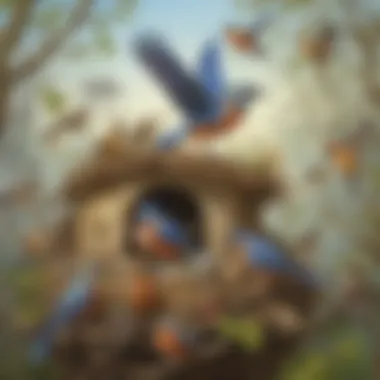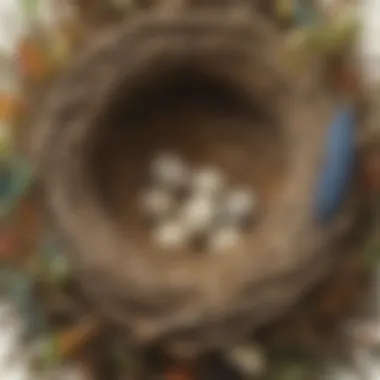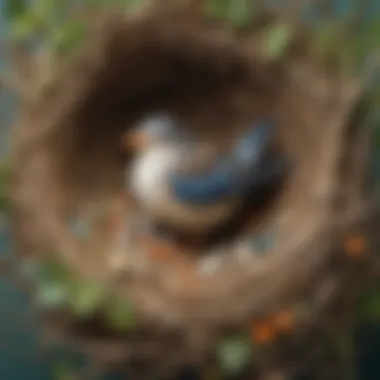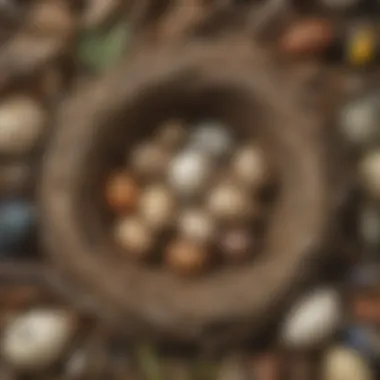Unveiling the Intricate Composition of Bird Nests: An Avian Architectural Marvel


Science Fun Facts
Bird nests are marvels of engineering, meticulously crafted by birds using a diverse range of materials. From twigs and leaves to mud and saliva, these tiny architects showcase remarkable ingenuity in constructing their cozy abodes. Did you know that some birds even incorporate man-made objects like plastic straws and paper into their nests?
Discover the Wonders of Science
In bird nest construction, each species displays unique preferences for materials, reflecting their adaptability and resourcefulness. Exploring the intricate compositions of these nests not only unveils the avian talent for design but also offers valuable insights into sustainable building practices. By observing how birds repurpose natural and artificial elements, we can learn to find creative solutions in our own habitats.
Science Quiz Time
Have you ever wondered how birds select the optimum materials for their nests? Test your knowledge with interactive quizzes that challenge you to think like a bird architect! Whether it's identifying the strongest nest-building materials or understanding the role of aesthetics in avian design, these brain teasers will keep you engaged while enriching your understanding of nature's engineering marvels.
Science Experiment Showcase
For a hands-on exploration of bird nest construction, try your hand at building a mini replica nest using twigs, straw, and other natural materials. Follow step-by-step instructions to mimic the construction process and gain a deeper appreciation for the skill and effort involved. By engaging in this experiment, you'll not only enhance your understanding of bird behavior but also foster a greater respect for the wonders of the natural world.
Prologue
Significance of Bird Nests
Importance of Nest Building in Bird Behavior
The foundation of avian heritage lies in the profound significance of nest building in bird behavior. A testament to instinctual prowess, nest construction embodies not mere shelter creation but a poignant representation of avian lineage. The meticulous selection of materials, strategic placement, and intricate design of nests epitomize the essence of bird prowess, underscoring their innate connection to the natural world.
Role of Nests in Bird Reproduction
Central to the perpetuation of avian populations, the role of nests in bird reproduction transcends mere structural significance. Nests serve as cradles of life, embodying incubation chambers for future generations of feathered denizens. The careful curation of nests, from construction to maintenance, plays a pivotal role in ensuring the survival and growth of avian communities, marking nests as revered sanctuaries of life.
Diversity of Bird Nest Types
Ground Nests
Ground nests, emblematic of simplicity and functionality, represent a primal form of avian architecture. Nestled amidst earthy textures, these nests epitomize a harmonious blend of camouflage and protection, offering a secure haven for ground-dwelling avian species. The strategic integration of natural elements within ground nests underscores the seamless integration of birds within their habitat, highlighting a primeval bond with the terrestrial realm.
Tree Nests
Elevating avian abodes to new heights, tree nests epitomize arboreal elegance and strategic positioning. Balanced delicately among branches, these nests symbolize a delicate dance between security and accessibility, offering avian occupants panoramic views and strategic vantage points. The architectural finesse showcased in tree nests elucidates avian adaptability and spatial awareness, marking them as nature's veritable sky-bridges of habitation.
Cavity Nests
Embracing the snug embrace of secluded spaces, cavity nests epitomize avian innovation within natural voids. From hollowed trunks to abandoned burrows, these nests reflect an ingenious adaptation to limited resources, harnessing pre-existing structures for nesting purposes. The utilization of cavities as nesting sites showcases avian resourcefulness and adaptability, marking these nests as epitomes of eco-friendly habitation.
Platform Nests
Ascending to aerial realms, platform nests symbolize the pinnacle of avian engineering amidst expansive horizons. Perched atop sturdy foundations, these nests offer birds commanding views and strategic positions for aerial patrols and nesting activities. The expansive nature of platform nests underscores avian mastery over open spaces, showcasing avian prowess in conquering the skies and establishing lofty abodes.


Factors Influencing Nest Composition
Bird Species
A cornerstone of nest diversity, bird species profoundly influence nest composition through their varied habits and instinctual behaviors. From meticulous weavers to adept foragers, each avian species contributes unique traits to nest construction, shaping the architectural landscape of avian abodes. The interplay between bird species and nest composition unveils a tapestry of avian diversity, underscoring the intricate bonds between avian identity and nesting practices.
Environmental Conditions
Navigating the caprices of nature, environmental conditions wield a profound influence on nest composition, guiding birds in material selection and structural design. From wind-swept terrains to sun-kissed environments, birds adapt nest composition to withstand climatic challenges and ensure structural integrity. The symbiotic relationship between environmental conditions and nest composition illuminates the adaptive prowess of avian architects, highlighting their resilience in the face of natural exigencies.
Availability of Resources
A defining factor in nest construction, the availability of resources shapes the material palette and design strategies adopted by nesting birds. From foraging expeditions to resource allocation, birds optimize resource utility to craft nests that blend harmoniously with their surroundings. The strategic utilization of available resources underscores avian resourcefulness and adaptability, portraying nests as living testaments to environmental sustainability and creative ingenuity.
Natural Materials in Bird Nests
The section on Natural Materials in Bird Nests within this article provides a deep dive into the essential elements that constitute avian abodes. From twigs and leaves to mud and feathers, the utilization of these materials is crucial in sculpting the cozy homes of our feathered friends. Understanding the significance of these natural materials offers insights into the intricate world of nest construction, highlighting the resourcefulness of birds in adapting to their environments.
Twigs and Branches
Types of Twigs Used
Diving into the realm of Types of Twigs Used, we uncover a myriad of selections that birds meticulously integrate into their nests. Each type, whether sturdy or pliable, serves a unique purpose in enhancing the structural integrity and insulation of the nest. The key trait of flexibility in certain twigs allows for optimal weaving, contributing to a durable final product. Despite variations in size and texture, the common thread among these twigs is their role in providing a stable foundation for the nest, showcasing why they remain a favored choice in avian architecture.
Significance of Branch Selection
In delving into the Significance of Branch Selection, we unravel the intricate thought process behind a bird's choice of branches. The selection is not arbitrary but based on factors such as strength, length, and even camouflaging abilities. Birds strategically pick branches that blend seamlessly with their habitat, offering both stability and disguise from potential predators. While this selection process may be time-consuming, the advantages of increased safety and structural support make it a worthwhile investment for our feathered architects.
Leaves and Grasses
Varieties of Leaves Employed
Exploring the Varieties of Leaves Employed uncovers a tapestry of colors and textures that birds deftly incorporate into their nests. Whether for insulation or camouflage, each leaf type plays a vital role in nest construction. The key characteristic of flexibility in some leaves enables birds to shape and mold their nests with precision, ensuring a snug fit for their eggs and young. Despite seasonal changes, the adaptability of leaves allows nests to remain comfortable and secure, showcasing the strategic utilization of natural resources.
Role of Grasses in Nest Construction
The Role of Grasses in Nest Construction sheds light on the versatile nature of these plants in avian architecture. Grasses provide a soft and cushioned lining for nests, offering both comfort and insulation. The distinctive feature of pliability in grasses allows birds to weave intricate patterns, enhancing the structure's durability. While the task of collecting grass may require time and effort, the benefits of a cozy and well-protected nest make it a critical component in avian homemaking.
Mud and Clay
Utilization of Mud for Binding
Unpacking the Utilization of Mud for Binding reveals the ingenious method by which birds employ this material in nest construction. Mud acts as a natural adhesive, binding different elements together and fortifying the nest's structure. The key characteristic of mud's malleability enables birds to sculpt and shape their nests according to their preferences, creating customized homes for their offspring. Despite the messiness that may be associated with mud, its cohesive properties contribute significantly to the longevity and stability of bird nests.
Clay Formation Techniques
Exploring the Clay Formation Techniques delves into the meticulous approach birds take in molding this material into functional components for their nests. Clay provides a waterproof seal, essential for protecting eggs and nestlings from the elements. The unique feature of clay's pliability enables birds to create intricate designs and partitions within their nests, optimizing space and insulation. While the process of clay formation may be labor-intensive, its benefits in enhancing nest durability and protection make it a preferred choice for avian architects.


Feathers and Fur
Insulation Properties of Feathers
Investigating the Insulation Properties of Feathers uncovers the remarkable ways in which birds use these materials to regulate temperature within their nests. Feathers trap heat, creating a cozy environment for eggs and nestlings, ensuring their survival in varying weather conditions. The key characteristic of feather flexibility allows birds to arrange them strategically, maximizing insulation and comfort. Despite the potential drawback of increased weight in the nest, the exceptional thermal regulation provided by feathers outweighs any minor inconveniences, making them an indispensable resource for avian parents.
Benefits of Fur in Nest Lining
The Benefits of Fur in Nest Lining highlight the additional layer of comfort and protection that this material offers in avian architecture. Fur serves as a soft and insulating lining, providing a cozy bed for young chicks. The unique feature of fur's soft texture adds a plush element to the nest, enhancing the overall comfort level. While collecting fur may require scavenging or grooming activities, the benefits of a warm and snug nest underscore its importance in ensuring the well-being and development of fledglings.
Unconventional Nest Materials
In the realm of bird nests, the exploration of unconventional nest materials stands as a compelling avenue for study. These materials, divergent from traditional natural elements, offer insights into the adaptive capabilities of avian species when faced with modern environmental challenges. By incorporating plastic and synthetic fibers, paper, string, and metallic objects into their nests, birds showcase remarkable versatility in their nesting practices. Understanding the role of unconventional materials provides a nuanced perspective on the intricate world of avian architecture.
Plastic and Synthetic Fibers
Impacts of Plastic Pollution on Nesting Birds
The presence of plastic pollution in bird nests highlights the grim reality of human impact on the environment. Plastic debris, often mistaken for food by birds, can lead to detrimental consequences for nesting birds and their offspring. The inadvertent ingestion of plastic can cause health issues, disrupt nesting behaviors, and ultimately threaten avian populations. Despite being a convenient material, the detrimental effects of plastic pollution underscore the urgent need for environmental conservation efforts to protect not only birds but also the delicate ecosystems they inhabit.
Innovative Use of Synthetic Fibers
In response to environmental challenges, birds have displayed remarkable adaptability by incorporating innovative synthetic fibers into their nests. These fibers, though man-made, offer unique advantages such as durability, insulation, and flexibility. The utilization of synthetic fibers showcases the resourcefulness of birds in adapting to changing environmental conditions. While synthetic fibers provide benefits in nest construction, it is crucial to consider potential drawbacks such as environmental pollution and long-term sustainability, thereby necessitating a balanced approach to avian habitat preservation.
Paper and String
Adaptation to Urban Environments
The adaptation of birds to urban environments has led to the incorporation of paper and string into nest construction. These urban materials present birds with accessible resources in human-altered landscapes, enabling them to thrive amidst urbanization. The strategic use of paper and string underscores birds' ability to innovate in response to anthropogenic changes, showcasing a resilience that is critical for their survival in evolving environments.
String Collecting Behavior
The behavior of collecting string for nests serves as a prime example of avian ingenuity. Birds exhibit a preference for certain types of string, showcasing a level of selectivity in material gathering for nest building. The meticulous collection of string demonstrates birds' attention to detail and highlights their sophisticated nest construction techniques. While string collecting behavior enhances the structural integrity of nests, careful consideration must be given to the implications of utilizing human-made materials in avian architecture.
Metallic Objects
Incidental Inclusion in Nests
The incidental inclusion of metallic objects in nests reflects the complex interactions between birds and their surroundings. Birds may incorporate metallic items such as wires or foil inadvertently, often attracted by shiny or reflective surfaces. While unintended, the presence of metallic objects in nests poses both advantages and challenges, emphasizing the dynamic nature of avian nesting habits in response to diverse environmental stimuli.
Metallic Element Attraction
The attraction of birds to metallic elements elucidates their innate curiosity and adaptability. Metallic objects, though atypical in natural nest composition, entice certain bird species, showcasing the diversity of material preferences among avian architects. The incorporation of metallic elements into nests raises intriguing questions about the role of aesthetics and environmental influence on avian nesting behaviors, underscoring the multidimensional aspects of avian architecture and the intersections between nature and human-made materials.
Human Influence on Nest Composition
The examination of Human Influence on Nest Composition within the realm of bird nests is a pivotal aspect of this article's exploration. It illuminates the remarkable impact that human activity has on the materials used by avian architects to construct their abodes. Through a meticulous analysis, we can discern the specific elements that influence nest composition, including the incorporation of urban debris and altered nesting behaviors due to human presence. Understanding this dynamic relationship is essential in comprehending the evolution of bird nesting practices and the adaptive strategies employed in response to human intervention.


Nest Building Adaptations
Integration of Urban Debris
Delving into the Integration of Urban Debris unveils a fascinating facet of nest building adaptations among birds. The utilization of materials such as plastic, metal, and other urban waste showcases the innate resourcefulness of avian species in transforming unconventional items into nesting components. This unique feature highlights the birds' adaptive capabilities, utilizing urban debris to their advantage in creating secure and resilient nests amidst challenging environmental conditions.
Altered Nesting Behaviors
The exploration of Altered Nesting Behaviors delves into the remarkable adjustments birds make in response to human influence. These changes in nesting behaviors reflect the adaptive nature of avian species, showcasing their ability to evolve and thrive in anthropogenically altered landscapes. By adapting their nesting strategies to urban environments, birds demonstrate resilience and ingenuity, ensuring the continuation of their nesting rituals despite human presence.
Conservation Concerns
Impact of Pollution on Nest Health
Examining the Impact of Pollution on Nest Health sheds light on the detrimental effects of human activities on avian nesting ecology. Pollution, ranging from chemical contaminants to microplastics, poses significant risks to nest health, influencing hatchability and fledgling survival rates. Understanding the correlation between pollution and nest health is crucial in implementing effective conservation measures to mitigate these detrimental impacts and preserve bird populations.
Efforts in Nest Protection
The discourse surrounding Efforts in Nest Protection underscores the critical initiatives undertaken to safeguard bird nests from human-induced threats. Conservation efforts, encompassing nest monitoring programs and habitat restoration projects, play a pivotal role in ensuring the longevity and vitality of avian nesting sites. By actively engaging in nest protection endeavors, individuals and organizations contribute to the conservation of avian species and the preservation of their nesting habitats.
Symbiotic Relationships with Humans
Beneficial Human-Nest Interactions
Exploring Beneficial Human-Nest Interactions reveals the mutually beneficial relationships that can exist between humans and nesting birds. Providing artificial nesting structures and enhancing habitat quality can bolster avian populations and promote biodiversity in urban and rural landscapes. These positive interactions highlight the potential for harmonious coexistence between humans and birds, fostering a conducive environment for avian nesting success.
Negative Impacts of Human Intervention
Delving into Negative Impacts of Human Intervention exposes the adverse effects of human activities on bird nesting behaviors and habitat integrity. Urbanization, pollution, and habitat destruction pose significant challenges to avian nesting success, leading to population decline and habitat degradation. Recognizing these negative impacts is essential in implementing conservation strategies that prioritize the protection of bird species and the preservation of their nesting habitats.
Ending
In the culmination of our exploration into the diverse composition of bird nests, we unravel the essence of avian architectural marvels. Detailed scrutiny of the materials utilized by birds unveils a world of resourcefulness and adaptability in nest building. This section magnifies the significance of acknowledging the intricate balance between preservation and development in avian habitats, emphasizing the critical role it plays in sustaining bird populations. Furthermore, we shed light on the essential aspect of raising awareness for sustainable nesting practices, underscoring its pivotal role in fostering coexistence between avian species and human environments. As we reflect on the profound insights gained from investigating bird nest compositions, we recognize the urgent need to prioritize conservation efforts and promote mindful practices for the holistic well-being of our feathered friends.
Implications for Avian Conservation
Balancing Preservation and Development
At the crux of avian conservation lies the delicate dance of balancing preservation and development, a nuanced concept vital for safeguarding bird habitats. The meticulous preservation of natural ecosystems is paramount to ensuring the survival of diverse bird species, whilst accommodating sustainable development to meet human needs harmoniously. This dual approach advocates for the sustainable utilization of resources without compromising the integrity of avian spaces. The juxtaposition of preservation and development presents a challenging yet rewarding path towards fostering ecological equilibrium, promoting cohabitation between avian communities and human societies.
Awareness for Sustainable Nesting Practices
Elevating awareness for sustainable nesting practices emerges as a cornerstone in avian conservation efforts, advocating for conscientious interaction with bird habitats. By imbuing communities with the knowledge of sustainable nest construction methods, we empower individuals to become stewards of avian welfare. The integration of sustainable practices not only safeguards bird populations but also nurtures a sense of environmental responsibility among human cohorts. Recognizing the intrinsic link between sustainable nesting practices and avian well-being underscores the significance of collective action in preserving biodiversity and creating a harmonious ecosystem.
Future Directions in Nesting Research
Technological Innovations in Nest Monitoring
Venturing into the realm of technological advancements, the integration of innovative monitoring tools revolutionizes nest surveillance. By leveraging cutting-edge technologies for nest monitoring, researchers can gain unprecedented insights into avian behaviors and habitat dynamics. This paradigm shift towards technology-driven monitoring not only enhances data collection accuracy but also augments conservation strategies aimed at safeguarding avian populations. The fusion of technology and avian research paves the way for a new era of efficient monitoring practices, fostering a deeper understanding of bird nesting behaviors.
Community Engagement in Nesting Studies
Emphasizing the paramount importance of community involvement in nesting studies, we illuminate the transformative impact of collective engagement. Engaging communities in nest studies not only enriches research endeavors but also instills a sense of ownership and responsibility towards avian conservation. By fostering partnerships between researchers and local communities, we bridge the gap between scientific inquiry and grassroots conservation efforts, creating a collaborative ecosystem for avian welfare. The symbiotic relationship between community engagement and nesting studies heralds a promising future of shared knowledge and concerted action towards safeguarding bird populations.







